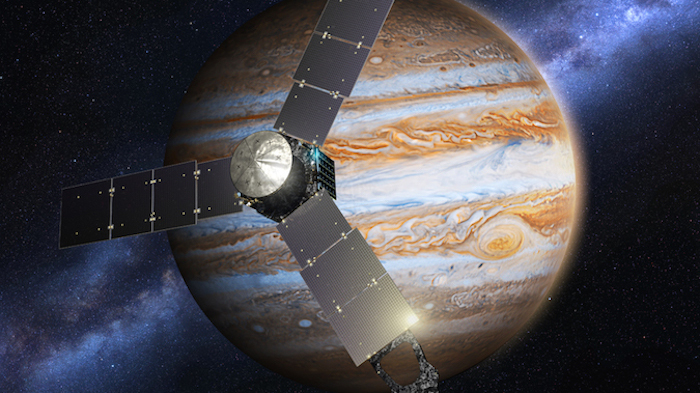6.08.2021
NASA’s Juno Celebrates 10 Years With New Infrared View of Moon Ganymede
The spacecraft used its infrared instrument during recent flybys of Jupiter’s mammoth moon to create this latest map, which comes out a decade after Juno’s launch.
The science team for NASA’s Juno spacecraft has produced a new infrared map of the mammoth Jovian moon Ganymede, combining data from three flybys, including its latest approach on July 20. These observations by the spacecraft’s Jovian Infrared Auroral Mapper (JIRAM) instrument, which “sees” in infrared light not visible to the human eye, provide new information on Ganymede’s icy shell and the composition of the ocean of liquid water beneath.
JIRAM was designed to capture the infrared light emerging from deep inside Jupiter, probing the weather layer down to 30 to 45 miles (50 to 70 kilometers) below Jupiter’s cloud tops. But the instrument can also be used to study the moons Io, Europa, Ganymede, and Callisto (known collectively as the Galilean moons in honor of their discoverer, Galileo).
“Ganymede is larger than the planet Mercury, but just about everything we explore on this mission to Jupiter is on a monumental scale,” said Juno Principal Investigator Scott Bolton of the Southwest Research Institute in San Antonio. “The infrared and other data collected by Juno during the flyby contain fundamental clues for understanding the evolution of Jupiter’s 79 moons from the time of their formation to today.”
Juno came within 31,136 miles (50,109 kilometers) of Ganymede, the solar system’s largest moon, on July 20, 2021. During earlier flybys on June 7, 2021, and Dec. 26, 2019, the solar-powered orbiter came within 650 miles (1,046 kilometers) and 62,000 miles (100,000 kilometers), respectively. The three observational geometries provided an opportunity for JIRAM to see the moon’s north polar region for the first time, as well as compare the diversity in composition between the low and high latitudes.
Ganymede is also the only moon in the solar system with its own magnetic field. On Earth, the magnetic field provides a pathway for plasma (charged particles) from the Sun to enter our atmosphere and create auroras. Because Ganymede has no atmosphere to impede their progress, the surface at its poles is constantly being bombarded by plasma from Jupiter’s gigantic magnetosphere. The bombardment has a dramatic effect on Ganymede’s ice.
“We found Ganymede’s high latitudes dominated by water ice, with fine grain size, which is the result of the intense bombardment of charged particles,” said Alessandro Mura, a Juno co-investigator from the National Institute for Astrophysics in Rome. “Conversely, low latitudes are shielded by the moon’s magnetic field and contain more of its original chemical composition, most notably of non-water-ice constituents such as salts and organics. It is extremely important to characterize the unique properties of these icy regions to better understand the space-weathering processes that the surface undergoes.”
Juno’s unique polar views and closeups of Ganymede build on observations by NASA’s previous explorers, among them Voyager, Galileo, New Horizons, and Cassini. Future missions with Ganymede in their travel plans include the ESA (European Space Agency) JUICE mission, which will explore the icy Galilean moons with an emphasis on Ganymede, and NASA’s Europa Clipper, which will focus on Ganymede’s neighboring ocean world Europa.
10 Years an Explorer
Juno lifted off from Cape Canaveral Air Force Station in Florida on Aug. 5, 2011, at 9:25 a.m. PDT (12:25 p.m. EDT). After a five-year, 1,740-million-mile (2,800-million-kilometer) journey, it arrived at Jupiter on July 4, 2016.
With three giant blades stretching out some 66 feet (20 meters) from its cylindrical, six-sided body, the Juno spacecraft is a dynamic engineering marvel, spinning to keep itself stable as it makes oval-shaped orbits around Jupiter. View the full interactive experience at Eyes on the Solar System.
“Since launch, Juno has executed over 2 million commands, orbited Jupiter 35 times, and collected about three terabits of science data,” said Project Manager Ed Hirst of JPL. “We are thrilled by our ongoing exploration of Jupiter, and there is much more to come. We have started our extended mission and look forward to 42 additional orbits to explore the Jovian system.”
Juno’s extended mission, which tasks the spacecraft with continuing its investigations through September 2025, includes close passes of Jupiter’s north polar cyclones, flybys of the moons Europa and Io (along with Ganymede), as well as the first exploration of the faint rings encircling the planet. It will also expand on discoveries Juno has already made about Jupiter’s interior structure, internal magnetic field, atmosphere (including polar cyclones, deep atmosphere, and aurora), and magnetosphere.
More About the Mission
JPL, a division of Caltech in Pasadena, California, manages the Juno mission for the principal investigator, Scott J. Bolton, of the Southwest Research Institute in San Antonio. Juno is part of NASA’s New Frontiers Program, which is managed at NASA’s Marshall Space Flight Center in Huntsville, Alabama, for the agency’s Science Mission Directorate in Washington. Lockheed Martin Space in Denver built and operates the spacecraft.
Quelle: NASA
----
Update: 27.10.2021
.
NASA to Host Briefing to Reveal New Findings from Jupiter’s Atmosphere

NASA will hold a virtual media briefing at 3 p.m. EDT Thursday, Oct. 28, to discuss the latest results from the agency’s Juno spacecraft. The science team will reveal new findings that provide the first 3D look at how the planet’s roiling atmosphere operates underneath the top layers of clouds, and how these revelations offer insight into the atmospheres of giant planets elsewhere in the universe.
The event will take place from NASA’s Jet Propulsion Laboratory in Southern California, which manages the Juno mission. It will be livestreamed on NASA Television, the NASA app, the agency’s website, NASA YouTube and Twitter.
Briefing participants include:
- Lucas Paganini, Juno program scientist, NASA Headquarters, Washington
- Scott Bolton, Juno principal investigator, Southwest Research Institute, San Antonio
- Marzia Parisi, Juno scientist, JPL
- Keren Duer, Juno scientist, Weizmann Institute of Science, Rehovot, Israel
- Leigh Fletcher, Juno participating scientist, University of Leicester, England
- Alessandro Mura, Juno co-investigator, Institute for Space Astrophysics and Planetology, Rome
To participate in the briefing by telephone, reporters must provide their name and affiliation no later than one hour before the start of the briefing to Rexana Vizza at: rexana.v.vizza@jpl.nasa.gov. Members of the media and the public may also ask questions on social media during the briefing using #JunoMission.
Juno has been orbiting and monitoring Jupiter since 2016. The spacecraft is now in an extended mission designed to expand on discoveries it already has made about Jupiter’s interior structure, internal magnetic field, atmosphere, and magnetosphere. It will also involve close passes of Jupiter’s north polar cyclones, future flybys of the moons Europa and Io, and the first exploration of the faint rings encircling the planet.
JPL, a division of Caltech in Pasadena, California, manages the Juno mission. Juno is part of NASA’s New Frontiers Program, which is managed at NASA’s Marshall Space Flight Center in Huntsville, Alabama, for the agency’s Science Mission Directorate in Washington. Lockheed Martin Space in Denver built and operates the spacecraft.
Quelle: NASA
----
Update: 30.10.2021
.
NASA’s Juno: Science Results Offer First 3D View of Jupiter Atmosphere
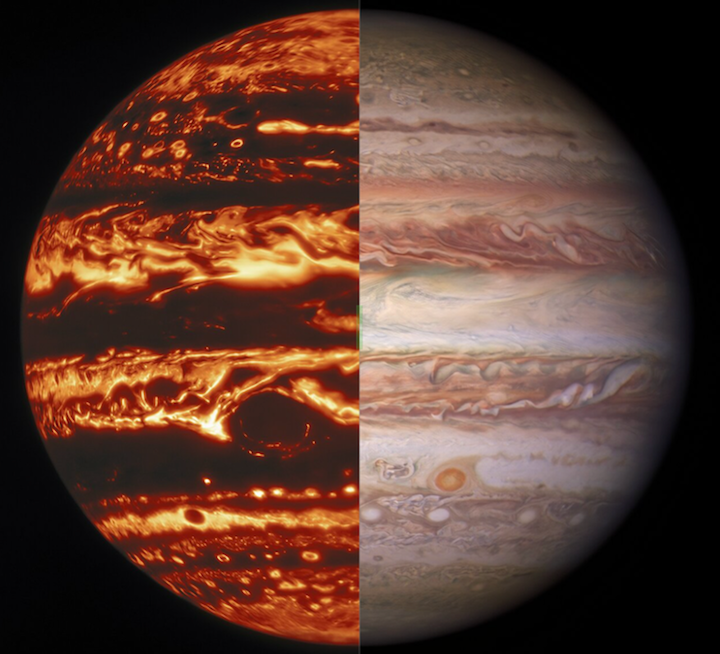
New findings from NASA’s Juno probe orbiting Jupiter provide a fuller picture of how the planet’s distinctive and colorful atmospheric features offer clues about the unseen processes below its clouds. The results highlight the inner workings of the belts and zones of clouds encircling Jupiter, as well as its polar cyclones and even the Great Red Spot.
Researchers published several papers on Juno’s atmospheric discoveries today in the journal Science and the Journal of Geophysical Research: Planets. Additional papers appeared in two recent issues of Geophysical Research Letters.
“These new observations from Juno open up a treasure chest of new information about Jupiter’s enigmatic observable features,” said Lori Glaze, director of NASA’s Planetary Science Division at the agency’s headquarters in Washington. “Each paper sheds light on different aspects of the planet’s atmospheric processes – a wonderful example of how our internationally-diverse science teams strengthen understanding of our solar system.”
Juno entered Jupiter’s orbit in 2016. During each of the spacecraft’s 37 passes of the planet to date, a specialized suite of instruments has peered below its turbulent cloud deck.
“Previously, Juno surprised us with hints that phenomena in Jupiter’s atmosphere went deeper than expected,” said Scott Bolton, principal investigator of Juno from the Southwest Research Institute in San Antonio and lead author of the Journal Science paper on the depth of Jupiter’s vortices. “Now, we’re starting to put all these individual pieces together and getting our first real understanding of how Jupiter’s beautiful and violent atmosphere works – in 3D.”
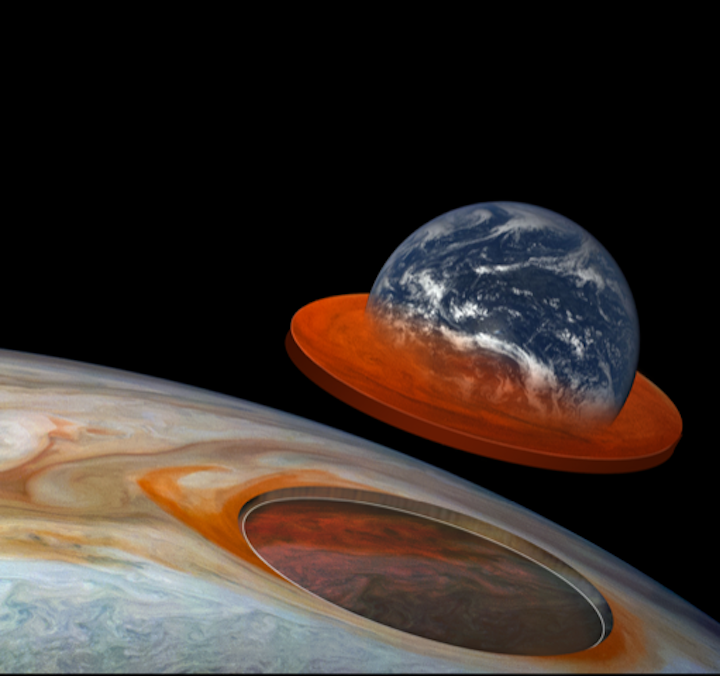
Juno’s microwave radiometer (MWR) allows mission scientists to peer beneath Jupiter’s cloud tops and probe the structure of its numerous vortex storms. The most famous of these storms is the iconic anticyclone known as the Great Red Spot. Wider than Earth, this crimson vortex has intrigued scientists since its discovery almost two centuries ago.
The new results show that the cyclones are warmer on top, with lower atmospheric densities, while they are colder at the bottom, with higher densities. Anticyclones, which rotate in the opposite direction, are colder at the top but warmer at the bottom.
The findings also indicate these storms are far taller than expected, with some extending 60 miles (100 kilometers) below the cloud tops and others, including the Great Red Spot, extending over 200 miles (350 kilometers). This surprise discovery demonstrates that the vortices cover regions beyond those where water condenses and clouds form, below the depth where sunlight warms the atmosphere.
The height and size of the Great Red Spot means the concentration of atmospheric mass within the storm potentially could be detectable by instruments studying Jupiter’s gravity field. Two close Juno flybys over Jupiter’s most famous spot provided the opportunity to search for the storm’s gravity signature and complement the MWR results on its depth.
With Juno traveling low over Jupiter’s cloud deck at about 130,000 mph (209,000 kph) Juno scientists were able to measure velocity changes as small 0.01 millimeter per second using a NASA’s Deep Space Network tracking antenna, from a distance of more than 400 million miles (650 million kilometers). This enabled the team to constrain the depth of the Great Red Spot to about 300 miles (500 kilometers) below the cloud tops.
“The precision required to get the Great Red Spot’s gravity during the July 2019 flyby is staggering,” said Marzia Parisi, a Juno scientist from NASA’s Jet Propulsion Laboratory in Southern California and lead author of a paper in the Journal Science on gravity overflights of the Great Red Spot. “Being able to complement MWR’s finding on the depth gives us great confidence that future gravity experiments at Jupiter will yield equally intriguing results.”
Belts and Zones
In addition to cyclones and anticyclones, Jupiter is known for its distinctive belts and zones – white and reddish bands of clouds that wrap around the planet. Strong east-west winds moving in opposite directions separate the bands. Juno previously discovered that these winds, or jet streams, reach depths of about 2,000 miles (roughly 3,200 kilometers). Researchers are still trying to solve the mystery of how the jet streams form. Data collected by Juno’s MWR during multiple passes reveal one possible clue: that the atmosphere’s ammonia gas travels up and down in remarkable alignment with the observed jet streams.
“By following the ammonia, we found circulation cells in both the north and south hemispheres that are similar in nature to ‘Ferrel cells,’ which control much of our climate here on Earth”, said Keren Duer, a graduate student from the Weizmann Institute of Science in Israel and lead author of the Journal Science paper on Ferrel-like cells on Jupiter. “While Earth has one Ferrel cell per hemisphere, Jupiter has eight – each at least 30 times larger.”
Juno’s MWR data also shows that the belts and zones undergo a transition around 40 miles (65 kilometers) beneath Jupiter’s water clouds. At shallow depths, Jupiter’s belts are brighter in microwave light than the neighboring zones. But at deeper levels, below the water clouds, the opposite is true – which reveals a similarity to our oceans.
“We are calling this level the ‘Jovicline’ in analogy to a transitional layer seen in Earth’s oceans, known as the thermocline – where seawater transitions sharply from being relative warm to relative cold,” said Leigh Fletcher, a Juno participating scientist from the University of Leicester in the United Kingdom and lead author of the paper in the Journal of Geophysical Research: Planets highlighting Juno’s microwave observations of Jupiter's temperate belts and zones.
Polar Cyclones
Juno previously discovered polygonal arrangements of giant cyclonic storms at both of Jupiter’s poles – eight arranged in an octagonal pattern in the north and five arranged in a pentagonal pattern in the south. Now, five years later, mission scientists using observations by the spacecraft’s Jovian Infrared Auroral Mapper (JIRAM) have determined these atmospheric phenomena are extremely resilient, remaining in the same location.
“Jupiter’s cyclones affect each other’s motion, causing them to oscillate about an equilibrium position,” said Alessandro Mura, a Juno co-investigator at the National Institute for Astrophysics in Rome and lead author of a recent paper in Geophysical Research Letters on oscillations and stability in Jupiter’s polar cyclones. “The behavior of these slow oscillations suggests that they have deep roots.”
JIRAM data also indicates that, like hurricanes on Earth, these cyclones want to move poleward, but cyclones located at the center of each pole push them back. This balance explains where the cyclones reside and the different numbers at each pole.
More About the Mission
JPL, a division of Caltech in Pasadena, California, manages the Juno mission. Juno is part of NASA’s New Frontiers Program, which is managed at NASA’s Marshall Space Flight Center in Huntsville, Alabama, for the agency’s Science Mission Directorate in Washington. Lockheed Martin Space in Denver built and operates the spacecraft.
Quelle: NASA
----
Update: 2.11.2021
.
Juno peers deep into Jupiter's colorful belts and zones
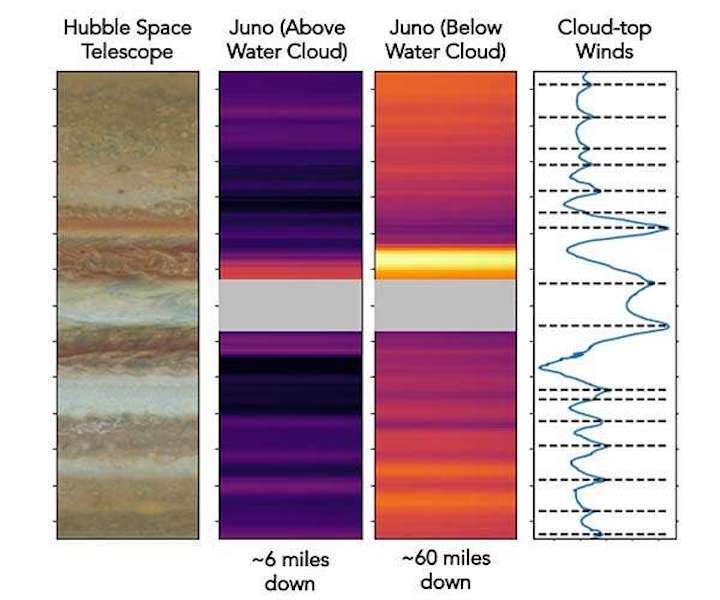
Jupiter's belts and zones observed in microwave light, compared to the colours of the cloud-tops (left), and the winds at the cloud tops (right). Two wavelengths of microwave light are shown, one sensing altitudes above the water cloud, and another sensing below the water clouds
Leicester study of data captured in orbit around Jupiter has revealed new insights into what's happening deep beneath the gas giant's distinctive and colourful bands.
Data from the microwave radiometer carried by NASA's Juno spacecraft shows that Jupiter's banded pattern extends deep below the clouds, and that the appearance of Jupiter's belts and zones inverts near the base of the water clouds. Microwave light allows planetary scientists to gaze deep beneath Jupiter's colourful clouds, to understand the weather and climate in the warmer, darker, deeper layers.
At altitudes shallower than five bars of pressure (or around five times the average atmospheric pressure on Earth), the planet's belts shine brightly in microwave light, whereas the zones are dark. But everything changes at higher pressures, at altitudes deeper than 10 bars, giving scientists a glimpse of an unexpected reversal in the meteorology and circulation.
Dr Leigh Fletcher, Associate Professor in Planetary Science at the University of Leicester and Participating Scientist for the Juno mission, is lead author of the study, published in the Journal of Geophysical Research-Planets. He said:
"One of Juno's primary goals was to peer beneath the cloudy veil of Jupiter's atmosphere, and to probe the deeper, hidden layers.
"Our study has shown that those colourful bands are just the 'tip of the iceberg', and that the mid-latitude bands not only extend deep, but seem to change their nature the further down you go.
"We've been calling the transition zone the jovicline, and its discovery has only been made possible by Juno's microwave instrument."
Among Jupiter's most notable attributes is its distinctive banded appearance. Planetary scientists call the light, whiteish bands zones, and the darker, reddish ones belts. Jupiter's planetary-scale winds circulate in opposite direction, east and west, on the edges of these colourful stripes. A key question is whether this structure is confined to the planet's cloud tops, or if the belts and zones persist with increasing depth.
An investigation of this phenomenon is one of the primary objectives of NASA's Juno mission, and the spacecraft carries a specially-designed microwave radiometer to measure emission from deep within the Solar System's largest planet for the first time.
The Juno team utilise data from this instrument to examine the nature of the belts and zones by peering deeper into the Jovian atmosphere than has ever previously been possible.
Juno's microwave radiometer operates in six wavelength channels ranging from 1.4 cm to 50 cm, and these enable Juno to probe the atmosphere at pressures starting at the top of the atmosphere near 0.6 bars to pressures exceeding 100 bars, around 250 km deep.
At the cloud tops, Jupiter's belts appear bright with microwave emission, while the zones remain dark. Bright microwave emission either means warmer atmospheric temperatures, or an absence of ammonia gas, which is a strong absorber of microwave light.
This configuration persists down to approximately five bars. And at pressures deeper than 10 bars, the pattern reverses, with the zones becoming microwave-bright and the belt becoming dark. Scientists therefore believe that something - either the physical temperatures or the abundance of ammonia - must therefore be changing with depth.
Dr Fletcher terms this transition region between five and 10 bars the jovicline, a comparison to the thermocline region of Earth's oceans, where seawater transitions sharply from relative warmth to relative coldness. Researchers observe that the jovicline is nearly coincident with a stable atmospheric layer created by condensing water.
Dr Scott Bolton, of NASA's Jet Propulsion Laboratory (JPL), is Principal Investigator (PI) for the Juno mission. He said:
"These amazing results provide our first glimpse of how Jupiter's famous zones and belts evolve with depth, revealing the power of investigating the giant planet's atmosphere in three dimensions."
There are two possible mechanisms that could be responsible for the change in brightness, each implying different physical conclusions.
One mechanism is related to the distribution of ammonia gas within the belts and zones. Ammonia is opaque to microwaves, meaning a region with relatively less ammonia will shine brighter in Juno's observations. This mechanism could imply a stacked system of opposing circulation cells, similar to patterns in Earth's tropics and mid-latitudes.
These circulation patterns would provide sinking in belts at shallow depths and upwelling in belts at deeper levels - or vigorous storms and precipitation, moving ammonia gas from place to place.
Another possibility is that the gradient in emission corresponds to a gradient in temperature, with higher temperatures resulting in greater microwave emission.
Temperatures and winds are connected, so if this scenario is correct, then Jupiter's winds may increase with depth below the clouds until we reach the jovicline, before tapering off into the deeper atmosphere - something that was also suggested by NASA's Galileo probe in 1995, which measured windspeeds as it descended under a parachute into the clouds of Jupiter.
The likely scenario is that both mechanisms are at work simultaneously, each contributing to part of the observed brightness variation. The race is now on to understand why Jupiter's circulation behaves in this way, and whether this is true of the other Giant Planets in our Solar System.
Quelle: SD
----
Update: 11.11.2021
.
In Jupiter's swirling Great Red Spot, NASA spacecraft finds hidden depths

This new perspective of Jupiter from the south makes the Great Red Spot appear as though it is in northern territory. This view is unique to Juno.
Jupiter is well-known for being the biggest planet in our solar system, and it's also home to the biggest storm. It's called the Great Red Spot, an enormous vortex that has been swirling for centuries. It's bigger than our own planet, and yet we don't know much about it. Until now, scientists could only observe the spot from afar. But thanks to a NASA spacecraft launched a decade ago, we're finally getting a look inside Jupiter's storm.
The Great Red Spot is like a storm here on Earth, but supersized. "It's basically clouds," says Paul Byrne, a planetary scientist at Washington University in St. Louis. Really, "it's not all that dissimilar to the kinds of things we know as cyclones or hurricanes or typhoons on Earth."
At 10,000 miles across, the Great Red Spot is the largest storm in our solar system and has been continually observed for around 200 years, but it's been around for much longer. (Compare that with big storms on Earth, which generally last a few days or weeks at most.)
"We believe this thing is really old," says Scott Bolton, principal investigator of NASA's Juno mission. "How it lasts that long is a mystery."
Before Juno, scientists could only observe the storm from afar. Even from a distance, they noticed it was changing shape and actually shrinking.
NASA's Juno mission launched from Cape Canaveral Space Force Station in Florida back in 2011 and arrived at Jupiter in 2016. In 2019, the spacecraft changed course slightly and passed over the Great Red Spot twice.
Bolton and his team used microwave sensors to slice into the depths of the storm, getting the first 3D model of the Great Red Spot. "It's a pancake, because it's so wide at the top. But the depth of that pancake is much thicker than what we would have anticipated."
The microwave observations show these storms on Jupiter, called vortices, extend below the cloud deck of the planet. In the case of the Great Red Spot, it extends at least 200 miles into the clouds of Jupiter, beyond the depths of where clouds form and water condenses.
"That's very different than the way we think Earth's atmosphere works, which is largely driven by water, clouds, condensation and sunlight," says Bolton. "How that works is going to require new models and new ideas to explain."
Measuring the Great Red Spot's gravity
During its 2019 pass over the Great Red Spot, the Juno spacecraft buzzed the planet at a blistering 130,000 miles per hour. The storm is so massive that its gravity field actually jostled the spacecraft during its flyby.
"The local gravity tends to pull and push away the spacecraft as it flies over the vortex, and this creates sort of like bumps in the road for Juno," says Marzia Parisi, a Juno scientist from NASA's Jet Propulsion Laboratory in Southern California and lead author of a paper in the journal Science on gravity overflights of the Great Red Spot.
Scientists here on Earth could see the effect of these gravitational "bumps." That's because every time they jostled Juno, they nudged the spacecraft closer to or farther from Earth. That changing distance caused the radio waves sent back to Earth some 400 million miles away to be subtly squeezed and stretched, a phenomenon known as a Doppler shift.
Using this effect, the spacecraft could pick up tiny jostles as small as 0.01 millimeters per second.
"The precision required to get the Great Red Spot's gravity during the July 2019 flyby is staggering," says Parisi. The findings from the gravity observations complemented Bolton's earlier microwave measures, concluding the storm penetrates some 300 miles into Jupiter's atmosphere.
The shrinking spot
Observations of the Great Red Spot show that it's shrinking. For nearly a century and a half, the iconic spot has been getting smaller and it's unclear just how long it will last.
Juno is taking a closer look at this phenomenon. "What we're doing is seeing up close what's happening while that shrinking has happened," says Bolton.
The spacecraft is observing flecks of the storm getting caught up in neighboring clouds. The storm itself also appears to be trapped by powerful conveyer belts of wind on the planet that are stabilizing the storm.
"I don't think the theory is very far advanced to the sense where we can connect all of that to the changes in the size," said Bolton.
Data from Juno will help scientists predict what could possibly happen to the Great Red Spot.
"Understanding what's happening with the storm now allows scientists to make much more sophisticated models to simulate what we see and then make predictions for what will happen in the future, including up to perhaps when the Great Red Spot may eventually go away," says planetary scientist Paul Byrne.
Understanding other Jupiter-like planets
The findings from the Juno spacecraft are shedding light on the early formation of giant planets like Saturn, Uranus and Neptune — and even planets beyond our own solar system.
"When we get up close, and this is the first planet we've actually been able to open up and look inside, this is going to tell us a lot about how giant planets work throughout the galaxy," says Bolton.
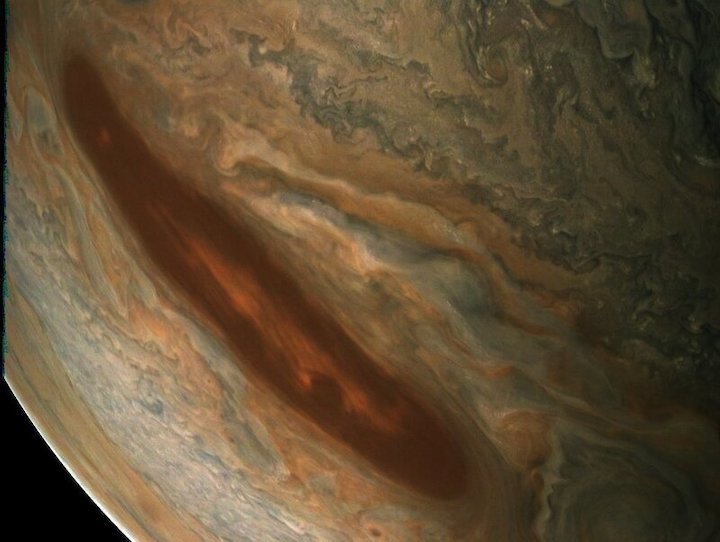
The JunoCam imager aboard NASA's Juno spacecraft captures a Jovian cyclone known as a barge type in polar jet stream called "Jet N4."
To date, astronomers have identified thousands of exoplanets — planets that orbit a star other than our sun. These planets are far away, with the closest one around 10.5 light-years from Earth. That makes observing what's happening on the surface difficult.
Around 1,400 of these exoplanet candidates are thought to be gas giants, much like Jupiter. Understanding what happens on Jupiter can help scientists get a better sense of what's happening beyond our solar system.
"By understanding the physics and the processes that go into shaping Jupiter," says Byrne, "we'll get a better better understanding of not just Jupiter, but of these kinds of worlds."
Quelle: npr
----
Update: 18.12.2021
.
NASA’s Juno Spacecraft ‘Hears’ Jupiter’s Moon
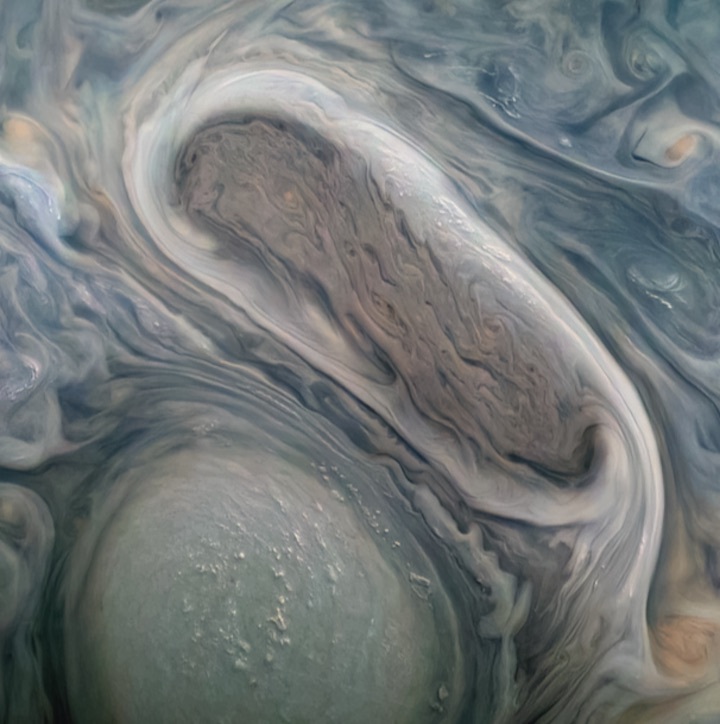
Jupiter storm
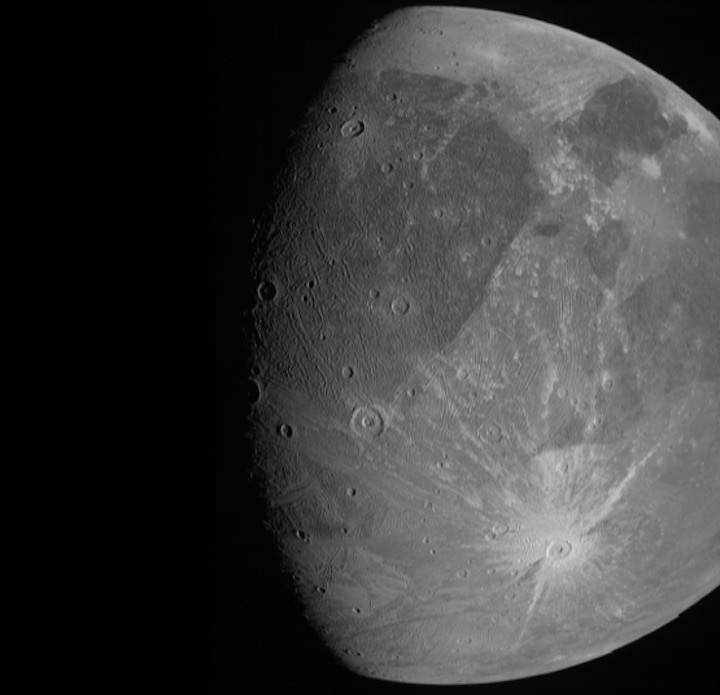
Ganymede
An audio track collected during Jupiter mission’s Ganymede flyby offers a dramatic ride-along. It is one of the highlights mission scientists shared in a briefing at American Geophysical Union Fall Meeting.
Sounds from a Ganymede flyby, magnetic fields, and remarkable comparisons between Jupiter and Earth’s oceans and atmospheres were discussed during a briefing today on NASA’s Juno mission to Jupiter at the American Geophysical Union Fall Meeting in New Orleans.
Juno Principal Investigator Scott Bolton of the Southwest Research Institute in San Antonio has debuted a 50-second audio track generated from data collected during the mission’s close flyby of the Jovian moon Ganymede on June 7, 2021. Juno’s Waves instrument, which tunes in to electric and magnetic radio waves produced in Jupiter’s magnetosphere, collected the data on those emissions. Their frequency was then shifted into the audio range to make the audio track.
“This soundtrack is just wild enough to make you feel as if you were riding along as Juno sails past Ganymede for the first time in more than two decades,” said Bolton. “If you listen closely, you can hear the abrupt change to higher frequencies around the midpoint of the recording, which represents entry into a different region in Ganymede's magnetosphere.”
Radio emissions collected during Juno’s June 7, 2021, flyby of Jupiter’s moon Ganymede are presented here, both visually and in sound.
Detailed analysis and modeling of the Waves data are ongoing. “It is possible the change in the frequency shortly after closest approach is due to passing from the nightside to the dayside of Ganymede,” said William Kurth of the University of Iowa in Iowa City, lead co-investigator for the Waves investigation.
At the time of Juno’s closest approach to Ganymede – during the mission’s 34th trip around Jupiter – the spacecraft was within 645 miles (1,038 kilometers) of the moon’s surface and traveling at a relative velocity of 41,600 mph (67,000 kph).
Magnetic Jupiter
Jack Connerney from NASA’s Goddard Space Flight Center in Greenbelt, Maryland, is the lead investigator with Juno’s magnetometer and is the mission’s deputy principal investigator. His team has produced the most detailed map ever obtained of Jupiter’s magnetic field.
Compiled from data collected from 32 orbits during Juno’s prime mission, the map provides new insights into the gas giant’s mysterious Great Blue Spot, a magnetic anomaly at the planet’s equator. Juno data indicates that a change in the gas giant’s magnetic field has occurred during the spacecraft’s five years in orbit, and that the Great Blue Spot is drifting eastward at a speed of about 2 inches (4 centimeters) per second relative to the rest of Jupiter’s interior, lapping the planet in about 350 years.
In contrast, the Great Red Spot – the long-lived atmospheric anticyclone just south of Jupiter’s equator – is drifting westward at a relatively rapid clip, circling the planet in about four-and-a-half years.
In addition, the new map shows that Jupiter’s zonal winds (jet streams that run east to west and west to east, giving Jupiter’s its distinctive banded appearance) are pulling the Great Blue Spot apart. This means that the zonal winds measured on the surface of the planet reach deep into the planet’s interior.
The new magnetic field map also allows Juno scientists to make comparisons with Earth’s magnetic field. The data suggests to the team that dynamo action – the mechanism by which a celestial body generates a magnetic field – in Jupiter’s interior occurs in metallic hydrogen, beneath a layer expressing “helium rain.”
Data Juno collects during its extended mission may further unravel the mysteries of the dynamo effect not only at Jupiter but those of other planets, including Earth.
Earth’s Oceans, Jupiter’s Atmosphere

Left to right: A phytoplankton bloom in the Norwegian Sea, and turbulent clouds in Jupiter’s atmosphere. Jupiter images provided by NASA’s Juno spacecraft have given oceanographers the raw materials to study the rich turbulence at the gas giant’s poles and the physical forces that drive large cyclones on Jupiter.
Lia Siegelman, a physical oceanographer and postdoctoral fellow at Scripps Institution of Oceanography at the University of California, San Diego, decided to study the dynamics of Jupiter’s atmosphere after noticing that the cyclones at Jupiter’s pole appear to share similarities with ocean vortices she studied during her time as a doctoral student.
“When I saw the richness of the turbulence around the Jovian cyclones, with all the filaments and smaller eddies, it reminded me of the turbulence you see in the ocean around eddies,” said Siegelman. “These are especially evident in high-resolution satellite images of vortices in Earth’s oceans that are revealed by plankton blooms that act as tracers of the flow.”
The simplified model of Jupiter’s pole shows that geometric patterns of vortices, like those observed on Jupiter, spontaneously emerge, and survive forever. This means that the basic geometrical configuration of the planet allows these intriguing structures to form.
Although Jupiter’s energy system is on a scale much larger than Earth’s, understanding the dynamics of the Jovian atmosphere could help us understand the physical mechanisms at play on our own planet.
Arming Perseus
The Juno team has also released its latest image of Jupiter’s faint dust ring, taken from inside the ring looking out by the spacecraft’s Stellar Reference Unit navigation camera. The brightest of the thin bands and neighboring dark regions scene in the image are linked to dust generated by two of Jupiter’s small moons, Metis and Adrastea. The image also captures the arm of the constellation Perseus.
“It is breathtaking that we can gaze at these familiar constellations from a spacecraft a half-billion miles away,” said Heidi Becker, lead co-investigator of Juno’s Stellar Reference Unit instrument at NASA’s Jet Propulsion Laboratory in Pasadena. “But everything looks pretty much the same as when we appreciate them from our backyards here on Earth. It’s an awe-inspiring reminder of how small we are and how much there is left to explore.”
Quelle: NASA

